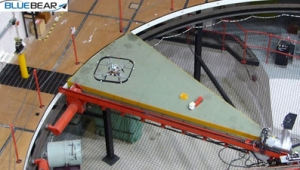Oct 4 2013
A group of researchers from Blue Bear Systems Research (BBSR) recently visited the National Physical Laboratory (NPL) to test and demonstrate a radiation survey system based on a small indoor aircraft. The tests took place in a specially designed, low-scatter experimental area at NPL, which is the only one of its kind in the UK.
 The UAV negotiates the experimental facility at NPL (image courtesy of BBSR)
The UAV negotiates the experimental facility at NPL (image courtesy of BBSR)
BBSR, known for its flight trials and rapid design of unmanned aerial vehicles (UAVs), has teamed up with Createc on 'Project Riser', which is funded by the UK's Technology Strategy Board and is being developed to help with the decommissioning of nuclear sites such as power stations. The joint expertise provides UAVs with autonomous control, search and exploration abilities. This means that in complex, potentially hazardous environments, a UAV can be used instead of a human.
The tests at NPL involved placing gamma sources around the experimental facility and were the first tests with live sources of radiation, giving BBSR the opportunity to demonstrate the effectiveness of their technology.
Dr Nigel Hawkes, from NPL's Neutron Metrology Group, said:
"Our experimental area was ideal for BBSR's flight tests, but its day job is as the home of our neutron production facilities. The 3.5 MeV Van de Graaff accelerator generates very well-characterised thermal (reactor-type) and monoenergetic neutron fields, and we also have radioisotope sources that provide standard spectra at precisely known intensities. The large size of the experimental area helps to reduce neutron backscatter from the walls and floor when we're doing high precision calibrations or tests of neutron dosemeters or detectors.
"The facility is unique in the UK and one of only a handful in the world."
A group of observers watched the aircraft navigate around a predetermined path while simultaneously mapping the environment and detecting radiation. It then revisited and investigated the areas where NPL scientists had positioned radiation sources by hovering over them to create a more detailed image.
Such data could be used to simulate responses and action at nuclear sites.
Dr Ian Cowling, Senior Scientist at BBSR, said: "We have a very specific application in mind: the nuclear industry. The technology will be applicable to nuclear decommissioning and cleanup at sites such as Fukushima and Sellafield."
Dr Nigel Hawkes added: "I understand that these flights were the final stage in BBSR's current drone testing project. However, development will undoubtedly continue, and the Neutron Metrology Group will be very happy to host further flight tests as they're needed."